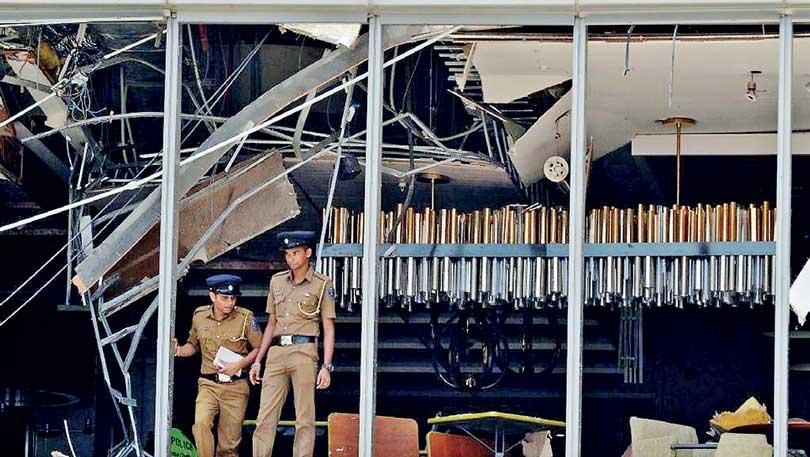21 Jun 2019 - {{hitsCtrl.values.hits}}

.Sri Lankan police stand at the site of an explosion in a restaurant area of one of the hotels attacked in Colombo on April 21 (AFP photo)
Moody’s Investors Service said the economic fallout from the Easter attacks runs deeper than portrayed, as the April 21 carnage has sent tremors across multiple key sectors from fiscal to the external sector, prompting the rating agency to slash its growth projections for the Sri Lankan economy.
Sri Lanka’s Census and Statistics office measured the economy to have grown by 3.7 percent during the first quarter, picking up from 1.8 percent in 4Q18 led by the strong agriculture sector recovery, which rebounded to 5.5 percent due to favourable weather.
But Moody’s in their latest report on Sri Lankan economy slashed the full year growth estimate to 2.6 percent from their previous estimate of 3.4 percent as they revisited their earlier projections after the country was hit by a string of terrorist attacks by radical Islamists.
“All in all, we expect real GDP growth of 2.6 percent in 2019, lower than our previous estimate of 3.4 percent. We forecast a pickup in real GDP growth to 3.4 percent in 2020, assuming a partial recovery in the tourism sector,” Moody’s stated.
In the aftermath of the attacks, the government continuously underplayed its economic impact and boasted how the foreign allies commended them for bringing the situation under control and re-establishing normalcy in public life sooner than others have hoped for.
The fresh dimmer outlook for the Sri Lankan economy comes from Moody’s estimate that the overarching impact from the slowdown in tourism and its spillover effects on allied industries such as retail and wholesale trade.
Although the tourism trade alone is said to be 5.0 percent of the Gross Domestic Product (GDP), the tourism industry with its associated industries accounts for 10 percent of the GDP, according to the World Travel and Tourism Council.
“The overall impact on tourism and GDP growth will hinge on how swiftly the government is able to restore a sense of security.
One mitigating factor is that Sri Lanka’s tourism industry had just reached the beginning of its low season, which could limit the fall in tourism receipts, given that more than half of arrivals and earnings come during the high season between November and March”, Moody’s opined.
Tourism trade generated US $ 4.4 billion in earnings in 2018 behind apparel exports.
It is estimated that a 25 percent decline in arrivals and fall in visitor spending will erase a minimum US $ 1.5 billion from the trade, which is akin to a percentage point of the GDP.
Moody’s also forecast a larger deficit in the external sector current account than what the government expecting due to the weak tourism inflows and the rise in duty free imports allowed for security related equipment, including scanners and metal detectors.
“This could push up the country’s import bill, although the potential for weaker imports from other sectors as a result of softer domestic demand might offset any increase,” the rating agency added.
The fresh estimate also takes account of the fiscal slippage arising from slower tourism, lack of steam in other sectors of the economy, the government relief package by way of lower value added tax (VAT) on hotels and tour operators and the weaker revenues from tourism development levies and embarkation tax.
Sri Lanka’s government reduced the VAT on hotels and tour operators to 7.0 percent from 15 percent from June 2019 to March 2020.
Although the impact on total State revenues from the lower VAT on tourism trade is slim, as tourism accounts for only 5 percent of total VAT income and 1.2 percent total State revenue, the slower economic growth would weigh heavily on the State coffers as the overall economic activities hobble.
“Overall, we expect fiscal deficits to remain around 5 percent of GDP in 2019-20, from 5.3 percent in 2018, and government debt to stay at about 82 -83 percent of GDP over the next few years – higher than many B-rated sovereigns, and the Sri Lankan government’s own projections” Moody’s stated.
Meanwhile, the rating agency also expects renewed political tension to resurface before and after the Presidential polls in 2019 and in the run up to the parliamentary polls in 2020 which could act as a dampener to the reform agenda, including the fiscal consolidation and institutional reforms, undermining the investor demand for Sri Lanka’s financial assets.
“Political tensions could also hurt GDP growth, particularly if social tensions rise”, Moody’s noted.
Meanwhile, the rating agency reiterated its position that Sri Lanka’s external debt refinancing risk remains elevated over the next 5 years, specially if the investor sentiments are subject to sudden shifts affecting the availability and the cost of these funding sources.
According to Moody’s estimates, Sri Lanka is due to make principal payments of more than US $ 3.0 billion every year from 2020 to 2024.
The Central Bank has so far been able to manage the debt repayments by rolling over the external debt at reasonable cost.
The Cabinet has this week approved the raising of Rs.480 billion under the Active Liability Management Act for debt repayments from 2020 to 2029, which is expected to provide the government with more space to manage debt.
25 Nov 2024 42 minute ago
25 Nov 2024 1 hours ago
25 Nov 2024 1 hours ago
25 Nov 2024 2 hours ago
25 Nov 2024 2 hours ago